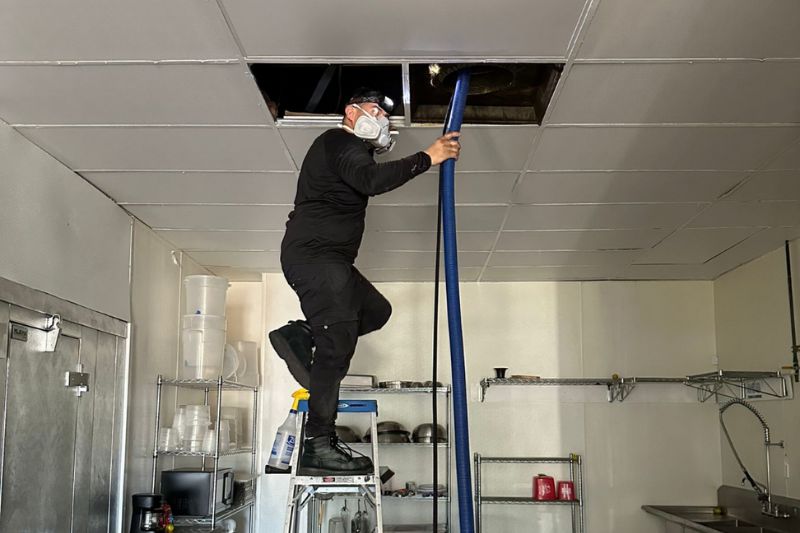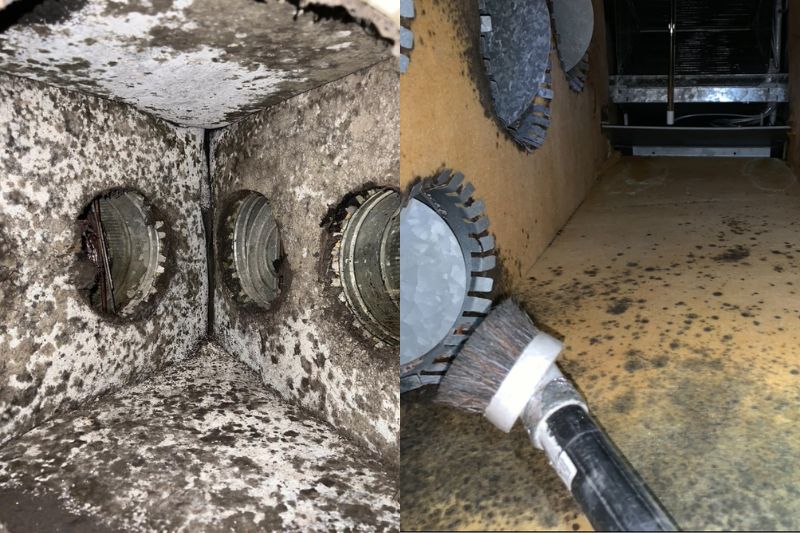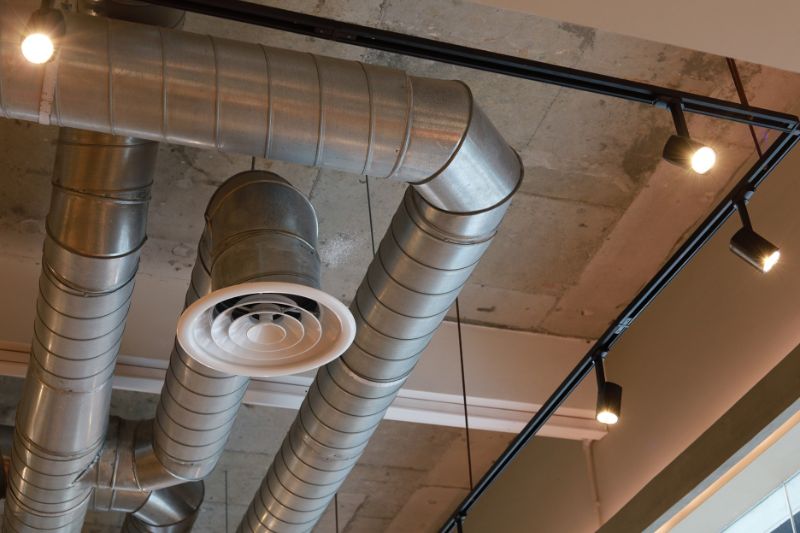Mold in HVAC ducts poses a serious risk to the health of your employees and customers. More importantly, customers who experience poor indoor air quality may experience allergy or asthma symptoms, causing them to avoid your business altogether.
For those reasons, you should know the seriousness of having mold in your HVAC ducts. This guide will cover everything you need to know, such as the signs of mold, causes, risks of having it, and how to remove mold from air ducts.
Can Mold Grow in HVAC Ducts?
Yes, mold can grow in your HVAC ducts.
The ideal environment for mold growth is warm and moist, such as your HVAC ducts. HVAC systems are a prime example of providing this environment, especially when your ductwork leaks, has poor seals, or has excess humidity and condensation.
In addition, dust and other organic materials (insects, rodent droppings, etc.) serve as food sources for mold, allowing it to thrive even further.

What Causes Mold in HVAC Ducts
While we’ve already hinted at some common causes of mold in HVAC ducts, it’s important we go into detail so that you can identify potential sources to prevent future problems.
The most common causes of mold in HVAC ducts include:
Excess Humidity
High humidity is one of the leading causes of mold in duct systems. When moisture levels rise, your ductwork becomes a prime candidate for mold spores to settle and multiply.
Causes of excess humidity include:
- Poor insulation
- Plumbing leak
- HVAC leak
- Roof leak
- High ambient humidity
Poor Ventilation
Without proper airflow, moisture tends to accumulate inside ducts. We often see this in rarely-used zones or systems that cycle on and off frequently. As a result, the poor ventilation traps moisture and enables mold spores to take root. Poor ventilation will also result in temperature imbalances, creating an uncomfortable work environment.
Dirty Components
Over time, HVAC ducts collect all types of contaminants: dust, dirt, dander, dead insects, droppings, and more. All of this organic material serves as a food source for mold spores. So, if not regularly cleaned, your ductwork acts as a nutrient-rich environment for spores.
Leaking Ductwork
Damaged ducts or poor seals enable warm, moist air to mix with cooler, drier air inside. The clash in temperatures can result in condensation accumulating inside the ductwork. This issue is compounded when the seasons change.
AC Drain Line Backups
If your air conditioner’s drain line is blocked or slow, water can back up into the HVAC system and pool in areas near the ducts. Stagnant water is a direct invitation for mold colonies to form.
According to the EPA, “Molds can be found almost anywhere; they can grow on virtually any organic substance, as long as moisture and oxygen are present.”
Is Mold in HVAC Dangerous?
Mold in HVAC systems can be considered dangerous because it can compromise indoor air quality. Mold worsens indoor air quality, which can have serious short-term and long-term health effects.
Short-term health effects of mold exposure include:
- Nasal congestion
- Coughing
- Sneezing
- Sore throat
- Eye or skin irritation
- Headaches
- Asthma attacks
If you’re exposed to mold for prolonged periods, you could experience:
- Chronic sinusitis
- Persistent coughing or wheezing
- Development of asthma
- Fatigue
- Cognitive or emotional issues
- Organ damage (although rare)
How Common is Mold in HVAC Ducts?
Mold in HVAC ducts is a frequent concern because of the combination of moisture, air, and organic material found in ducts.
According to the CDC, 50% of all HVAC systems show evidence of moisture buildup, meaning they’re ideal for mold colonies to start.
The best way to reduce your chances of mold in HVAC systems is to seek regular inspections and cleanings. These services can identify areas of concern, such as moisture buildup, duct leaks, and early signs of mold.
Signs of Mold in HVAC Ducts
If you’re unsure of mold in your HVAC ducts, there are signs to look for. However, we highly recommend contacting a professional HVAC cleaning and mold removal company like Top Star Air Pros. A professional has all the necessary experience and equipment to inspect your HVAC system for mold.
With that said, look for these signs if you suspect mold in your HVAC ducts:
- Musty/mildew odor: Consistently smelling an earthy or musty smell, especially when your HVAC system kicks on, can be a sign of mold in ductwork.
- Visible mold: Mold appears as dark, fuzzy patches on vent covers, inside ducts, or HVAC components (drip pans, air filters, etc.) Keep an eye out for mold in these areas because it likely means there is more elsewhere.
- Respiratory condition symptoms: If you or others experience symptoms of allergic reactions or respiratory conditions while only in the building, it’s likely a sign of poor indoor air quality contributed by mold.
- Poor HVAC performance: A poorly performing HVAC can be caused by a number of sources, but mold buildup can reduce efficiency and airflow. With that said, if mold isn’t the cause, a poor HVAC performance will lead to mold, so get it looked at immediately.
- Presence of water: If you notice water buildup around the HVAC unit, condensation on ductwork or vents, or water leaks throughout the building, there’s a good chance moisture has entered your ductwork. Thus, mold is likely present or will be soon.
- Black dust: Black dust blowing from your vents or accumulating around ductwork could be a sign of mold. However, black dust could also be dirt or dust, so it’s not a sure sign of mold in HVAC systems.

How to Get Rid of Mold in HVAC Ducts
Discovering mold in your HVAC ducts is alarming, but it’s not something you should try to tackle yourself. HVAC mold removal requires professional experts who are experienced, licensed, and insured for the job.
Before any decisions are made, it’s critical to understand the full extent of the problem. So, the professional, like Top Star Air Pros, will need to perform a thorough inspection of the ductwork.
Once we understand the scope of the problem, we can provide the best course of action.
When performing the HVAC mold inspection, we’ll look for the following:
- The root causes of moisture or contamination
- Whether the mold is isolated or widespread throughout the system
- If any ductwork or HVAC components are damaged or beyond cleaning
Cleaning vs. Replacing HVAC Ductwork
After assessing the mold in HVAC systems, we’ll recommend one of two solutions:
Professional HVAC mold cleaning: If the mold is localized and the ductwork is structurally sound, a deep cleaning using industry-grade tools and EPA-approved antimicrobial treatments may be all that is needed. Overall, this process includes cleaning the ducts, coils, drip pans, and all other areas prone to mold.
Ductwork replacement: In more severe cases, where the mold has penetrated porous materials, caused damage, or has grown widespread through the system, the best course of action may be to replace sections of ductwork entirely. This ensures the mold is completely removed and won’t return due to residual contamination.
Why You Shouldn’t DIY
DIY methods like spraying disinfectant into vents or wiping visible mold only treat the surface and can worsen the problem by spreading spores or damaging components.
Without proper containment, air filtration, and equipment, mold removal can pose health risks to you and others in the building. So, please request an inspection from your local HVAC mold professional, like Top Star Air Pros in Houston.
Best Practices to Prevent Mold in HVAC Systems
Preventing mold in your HVAC system is far easier — and cheaper — than removing it. Fortunately, there are many steps you can take to reduce the chances of mold taking hold of your HVAC ductwork.
- Keep humidity levels below 60%
- Use a dehumidifier
- Schedule annual HVAC maintenance
- Install a UV light system to kill mold spores
- Make sure your home or business is properly insulated
And if preventing mold growth isn’t enough motivation to take these proactive steps, according to the National Air Duct Cleaners Association (NADCA), homes and businesses with clean HVAC systems can experience up to 40% more energy efficiency. In other words, you save even more money if your HVAC system stays clean.
Breathe Easier Without Mold in HVAC Ducts
Understanding the root causes of mold in HVAC ducts is the key to clean, breathable air. Don’t wait until mold becomes a costly health hazard; address it today with expert help from your local pros.
Need expert help? Talk to our Top Star Air Pros Duct Cleaning team to connect with trusted HVAC professionals in the Greater Houston area.


